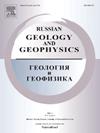Composition of the Fluid in Carbonate- and Chlorine-Bearing Pelite near the Second Critical Point: Results of Diamond Trap Experiments
IF 1
4区 地球科学
Q3 GEOSCIENCES, MULTIDISCIPLINARY
引用次数: 2
Abstract
––The composition of the fluid in carbonate- and chlorine-bearing pelite was experimentally studied at 3.0 GPa and 750 and 900 ºC, using the diamond trap method. The results of inductively coupled plasma atomic-emission spectrometry (ICP AES) and mass balance calculations showed that a supercritical fluid formed in the studied system at 3.0 GPa and 750 °C. The fluid is Si- and Al-rich and contains 30–50 wt.% H2O + CO2 and up to 1 wt.% Cl. The contents of other major elements decrease in the order: K > Na > Сa ≈ Fe > Mg > Mn > Ti ≈ P. Compared with supercritical fluids appeared in the systems pelite–H2O and eclogite–H2O, the fluid with high CO2 and Cl contents is richer in Fe, Ca, Mg, and Mn but poorer in Si. Silicate melt generated in this system at 900 ºС has a composition typical of pelitic melt. Our experiments reveal a set of fingerprints of element fractionation between a supercritical fluid and solids forming an eclogite-like association, namely, high mobility of P, Sr, and B and low mobility of Li and S. Thus, a supercritical fluid compositionally similar to the pelitic melts generated in subduction zones can transfer significant amounts of both volatiles (H2O, CO2, Cl, and P) and major components to the regions of arc magma generation. It is important that supercritical fluids should have trace element signatures of diluted low-temperature fluids.第二临界点附近含碳酸盐和含氯泥铁矿流体组成:金刚石圈闭实验结果
––在3.0 GPa、750ºC和900ºC下,使用金刚石陷阱法对碳酸盐和氯泥质岩中的流体成分进行了实验研究。电感耦合等离子体原子发射光谱法(ICP-AES)和质量平衡计算结果表明,在3.0GPa和750°C下,所研究的系统中形成了超临界流体。该流体富含硅和铝,含量为30–50 wt.%H2O+CO2和高达1wt.%Cl。其他主要元素的含量依次降低:K>Na>Сa≈Fe>Mg>Mn>Ti≈P。与泥质岩-H2O和榴辉岩-H2O系统中出现的超临界流体相比,CO2和Cl含量高的流体富含Fe、Ca、Mg和Mn,而贫含Si。该系统在900ºС下产生的硅酸盐熔体具有典型的泥质熔体组成。我们的实验揭示了超临界流体和形成类榴辉岩组合的固体之间的一组元素分馏指纹,即P、Sr和B的高迁移率和Li和S的低迁移率。因此,与俯冲带中产生的泥质熔体成分相似的超临界流体可以将大量的挥发物(H2O、CO2、Cl和P)和主要成分转移到弧岩浆生成区域。重要的是,超临界流体应具有稀释低温流体的微量元素特征。
本文章由计算机程序翻译,如有差异,请以英文原文为准。
求助全文
约1分钟内获得全文
求助全文
来源期刊

Russian Geology and Geophysics
地学-地球科学综合
CiteScore
2.00
自引率
18.20%
发文量
95
审稿时长
4-8 weeks
期刊介绍:
The journal publishes original reports of theoretical and methodological nature in the fields of geology, geophysics, and geochemistry, which contain data on composition and structure of the Earth''s crust and mantle, describes processes of formation and general regularities of commercial mineral occurrences, investigations on development and application of geological-geophysical methods for their revealing. As to works of regional nature, accelerated publication are available for original papers on a variety of problems of comparative geology taking into account specific character of Siberia, adjacent Asian countries and water areas. The journal will also publish reviews, critical articles, chronicle of the most important scientific events, and advertisements.
 求助内容:
求助内容: 应助结果提醒方式:
应助结果提醒方式:


